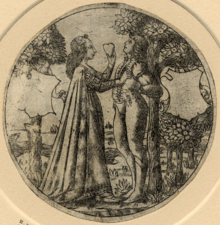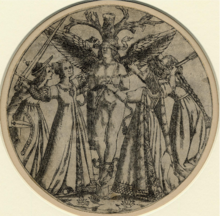
The Otto prints are a group of small 15th-century engravings made in Florence in the Fine Manner style. Between 24 and slightly over 40 prints are usually included in the group, depending on the scholar. Most are only known in a single surviving impression (copy), despite many showing clear signs of wear and reworking of the plate. They are often rather tentatively attributed to Baccio Baldini or his workshop, and dated to c. 1465–80.[2] A few are "clearly by different hands" from the rest.[3]
Unusually, they are all circular or oval, and their mostly secular subjects often feature themes of love, romance and courtship.[4] Cherubs or putti feature in many, and there are some rather vague allegories. Many have elaborate borders of fruit, and sometimes figures. Hunting is another subject, and there are a few religious figures.[5] They are probably designed to appeal to female tastes, unlike most secular art of the period, and "reveal a Renaissance voice husky from reveling".[6] A. Hyatt Mayor remarked that "Florence, like Japan, has for centuries graced daily life with delightful trinkets".[7]

Most of the group, 24 prints, were part of the collections of "the infamous spy and antiquary" Baron Philipp von Stosch (1731–1757) and then Ernst Peter Otto (1724–1799),[9] both Germans, after which the original group of 24 prints was auctioned and divided, with the British Museum buying the largest group. Scholars are mostly agreed that the surviving examples were from an album of samples held by a retailer, who sold them for use decorating the lids of other objects, "the covers of round or oblong toilet-boxes or work-boxes for ladies" as Hind puts it, or perhaps marriage caskets or small boxes of confectionery given as presents at weddings, betrothal ceremonies or the like, after which they might be reused by the recipient.[10]

Many of the prints have one or two blank shields or other spaces for heraldry; in some of the examples coats of arms have been added in ink, which was evidently the intention. Those with two spaces suggest they were related to a marriage. The space for heraldry suggests these prints, which must have been expensive, were intended for elite customers.[12] Several have elaborate "self-borders" of garlands and flowers in the latest Renaissance styles, suggesting that they may have been pasted to card and hung on a wall, and also possibly used as patterns by artisans in more permanent materials.[13]
- ^ BM 1852,0424.7 "The Cruelty of Love; a woman showing the heart just plucked from the chest of a young man who is bound to a tree"; Bayer, 92
- ^ Levinson, 15, later supported by Mark J. Zucker in his volume of The Illustrated Bartsch, see Schmidt, 162
- ^ Levinson, 15, note 5 (quoted); Randolph, 225; Christie's
- ^ Levinson, 15
- ^ Randolph, 224–225
- ^ Randolph, 224–225 (quoted)
- ^ Mayor, 89
- ^ BM 1852,0424.8, who say: "The Chastisement of Cupid; in the centre Cupid, blindfolded with arms behind his back, bound to a trunk and attacked by a group of four women with shears, a sword and a mace; the sleeves of one woman are inscribed: 'AMOR VUOL FE'"
- ^ Schmidt, 162
- ^ Levinson, 15; Mayor, 89
- ^ BM 1852,0424.1
- ^ Stermole, 75–77; Randolph, 224
- ^ The Frame blog
© MMXXIII Rich X Search. We shall prevail. All rights reserved. Rich X Search
